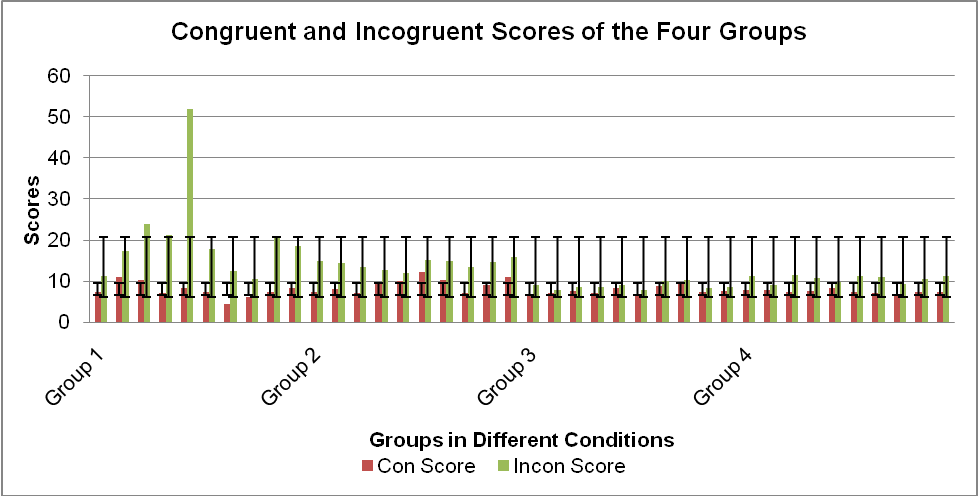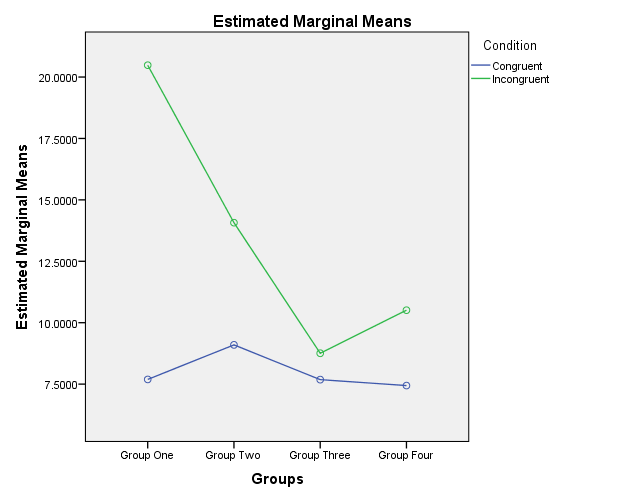Abstract
The core aim of the Stroop experiment was to reveal the differences in perception of congruent and incongruent words. The study hypothesized that the nature of words influences the reading rates among students. First, the paper focused on the research plan involving such aspects as hypotheses and methods where the latter specifies the design, procedure, materials, and other relevant components of the experiment. Descriptive statistics and mixed-design ANOVA was used in analyzing the data presented in the Appendix. The section of the discussion provided some insights into the interpretation of results associated with interference. Finally, the conclusion embraced key points of the research and identified limitations along with the prospective studies.
Introduction
Stroop effect refers to the process of automatic determination of the semantic meaning of colors. According to Flaudias and Llorca (2014), the basis of this effect is the difference between theoretical and practical logic of visual perception. This effect is successfully used in psychology as a diagnostic tool that determines the attention as well as the development of logic and theoretical aspects of perception (Lamers, Roelofs, & Rabeling-Keus, 2010). Therefore, this paper aims to examine the Stroop experiment in order to verify the assumptions suggested by the scholar.
Hypotheses
The study hypothesized that students read congruent words faster than incongruent ones.
Methods
Participants
The study employed an opportunistic/volunteer method in conducting the research among students while assuming the inclusion of other participants.
Design
In the framework of the repeated-measure design, participants took part in both conditions yet only in one group. As there were four groups, the first group of participants reads congruent words before incongruent ones while the second group read them in vice versa. The third group participants completed the congruent list words before reading the alternative list of incongruent ones, and members of the fourth group read them in vice versa.
Stimuli and Materials
The following equipment was used to conduct the experiment: a timer, word lists, and consent forms.
Procedure
Every participant was provided with a consent form and instructions, explaining the course of the experiment. Then they were tested and timed in a safe environment, either at home or any other convenient place. The allocation of participants to groups was made randomly and the results were recorded either on computer or paper.
Ethics and Risk
No one under 18 was invited to participate in the experiment. The communication with participants was provided in an appropriate and correct manner to minimize any misunderstandings.
Results
Table 3 in the Appendix illustrates the data that was collected during the experiment. The number of respondents amounted to 40 people (23 Females and 17 males) aged between 19 and 60 (M = 29.88, SD = 1.99).
Table 1.
Descriptive statistics in Table 1 show the mean and the standard deviation of congruent and incongruent scores of participants in four groups, which represent diverse conditions of the Stroop experiment. In group one, there is apparent huge difference in scores as congruent scores (M = 7.69, SD = 1.87) are lower than incongruent scores (M = 20.48, SD = 11.87). In the second group, there is moderate difference in scores as congruent scores (M = 9.10, SD = 1.72) are lower than incongruent score (M = 14.07, SD = 1.27).
The scores of group three show that there is slight difference as congruent scores (M = 7.68, SD = 0.94) are lower than incongruent scores (M = 8.75, SD = 0.80). The participants in group four have congruent scores (M = 7.44, SD = 0.37), which are lower than that of incongruent scores (M = 10.51, SD = 0.91). Overall, comparison of congruent and incongruent scores shows that they have marked differences. Essentially, the congruent scores are lower (M = 7.98, SD = 1.47) than incongruent scores (M = 13.46, SD = 7.34), which means that participants read congruent words faster than incongruent words.

Figure 1 shows that the error bars with the standard deviation of incongruent scores are more variable than error bars with the standard deviation of congruent scores.

Figure 2 shows the distribution of means and it exhibits that there are apparent differences in means among the four groups of participants under different experimental conditions. In summary, the means of incongruent scores are higher than the means of congruent scores.
To determine if the apparent differences in congruent and incongruent between and within the groups, the study employed 2 by 2 mixed-design ANOVA as an inferential test.
Table 2.
In the main effects, the ANOVA test shows that there is a statistically significant difference in reading rates between participants in different groups, F(3), = 7.53, p = 0.000. The ANOVA test means that different conditions of the Stroop experiment influence reading rates among participants. Moreover, the ANOVA test shows there is a statistically significant difference in reading rates when participants read congruent words and incongruent words, F(1) = 31.71, p = 0.000. The test means that the nature of words influences the reading rates among participants. Since both conditions of the experiment and the nature of words influence the reading rates among students, the study determined the interaction of variables. Evidently, the interaction of the group and the nature of words statistically significantly influences the reading rates among participants. Therefore, the ANOVA test supports the hypothesis that people can read congruent words faster than incongruent words irrespective of the experimental conditions.
Discussion
It should be emphasized that the purpose of this experiment requires the performance of two tasks simultaneously one of which is regulated by the instruction, and the second one is to ignore the color. The practice shows that regardless of age and gender of participants, the interference effect was always observed, and its value was directly dependent on the effectiveness of the level of abstraction. In the role of stimuli in the Stroop experiment, there were the words of different colors such as red, green, blue, yellow, and black. If the congruent list included words painted in the corresponding color, every single word in the incongruent list was painted in a color that did not correspond to the color which was denoted by the semantics of the word. The task set by participants was to call the color of words, abstracting from the colors in which they were painted.
Analyzing the effects of the Stroop experiment, in particular, the time of responses and studying the sources related to the issue, certain conclusions can be identified. Considering the results in the context of interference, the reading reaction of congruent words is obviously more stable than those of incongruent. These associative ties that were formed between verbal stimuli and color stimuli are the result of the training, and the difference in their strength is a rough equivalent to the difference in the practical use of reading words and naming of colors.
The initiated Stroop experiment indicates that primarily the words were read automatically, and their semantic meaning was mixed with the task of color identification. In effect, this manifested in an increase of reaction time to respond and the occurrence of errors. Interestingly, the effectiveness of the implementation of Stroop experiment seems to depend on the ability of respondents to successfully cope with the task of ignoring the background stimulation (Galer et al., 2014). Thus, perceptual interference, which manifests itself in the course of the experiment, is an expression of the superiority of the background.
As for gender differences in the performance of the Stroop task, there is a reliably established fact that women cope with the naming of colors in the incongruent list better than men. This effect was also pointed out by Eysenck and Groome (2015) who observed that it emanates from women’s frequent practice of naming colors in everyday life. According to Galer et al. (2014), “age may also play a role in the expression of these effects” (p. 99). This phenomenon can be explained by the fact that usually, young people tend to prioritize the actual state of an object, while adults are prone to associations and abstract thinking.
The respondents demonstrated the ability to read the words faster than to recognize, remember, and name a certain color. The phenomenon occurs when one type of information causes interference when superimposed on the other (Gul & Humphreys, 2015). In this view, one can note a cognitive bias that is referred to as the distortion of human perception. However, it should be noted that the Stroop effect is an ambiguous phenomenon that involves a range of cognitive mechanisms (Chen, Tang, & Chen, 2013). Precisely speaking, a great emphasis is placed on the degree of automation of such processes as a reading of words when a person does not delve into the meaning while reading them.
The credibility of the experiment is ensured by various references to other reliable studies as well as the timeliness. Consequently, the goal of the study was achieved as the results provide an average reader with useful and comprehensible information. However, the limitation is that this research cannot be generalized to the whole country or society as every population can have its own peculiar features affecting the reading response. Thus, the methodology of potential research can investigate the topic through both qualitative and quantitative methods to make the study more inclusive and relevant.
Conclusion
Thus, based on the obtained results, the study revealed that the participants tend to read congruent list words faster than those of the incongruent one. Moreover, women showed better results due to their everyday practice in naming colors. In general, it is possible to state that the hypothesis identified initially was proved.
Appendix
Table 3. Raw Data Collected.
References
Chen, A., Tang, D., & Chen, X. (2013). Training reveals the sources of Stroop and Flanker interference effects. PLoS One, 8(10), 1-8.
Eysenck, M. W., & Groome, D. (2015). Cognitive psychology: Revisiting the classic studies. Los Angeles, CA: Sage.
Flaudias, V., & Llorca, P. (2014). A brief review of three manipulations of the Stroop task focusing on the automaticity of semantic access. Psychologica Belgica, 54(2), 199-221.
Galer, S., Schmitz, R., Leproult, R., Tiège, X. D., Bogaert, P. V., & Peigneux, P. (2014). Response-stimulus interval duration modulates interference effects in the Stroop task. Psychologica Belgica, 54(1), 97-110.
Gul, A., & Humphreys, G. W. (2015). Practice and color-word integration in Stroop interference. Psicológica, 36(5), 37-67.
Lamers, M. J., Roelofs, A., & Rabeling-Keus, I. M. (2010). Selective attention and response set in the Stroop task. Memory & Cognition, 38(7), 893-904.